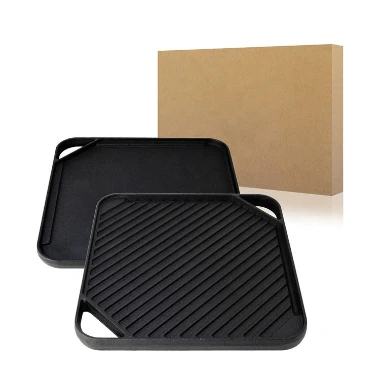
Benefits of Cooking with a Seasoned Cast Iron Dutch Oven for Delicious Meals
The Timeless Appeal of a Seasoned Cast Iron Dutch Oven
The seasoned cast iron Dutch oven is more than just a cooking vessel; it is a culinary icon that has stood the test of time. Revered by chefs and home cooks alike, this heavyweight champion of the kitchen is celebrated for its unbeatable heat retention, versatility, and ability to develop flavor over time. Whether you're braising, baking, frying, or simmering, this beloved piece of cookware is an indispensable tool that can elevate any dish.
History and Heritage
The Dutch oven's origins can be traced back to the 18th century in the Netherlands, where cast iron was first used for cookware. The earliest Dutch ovens were made from sturdy cast iron and featured a tight-fitting lid, which allowed for even cooking and moisture retention. These pots quickly gained popularity due to their durability and ability to disperse heat evenly. As settlers brought Dutch ovens to America, they adapted its design, leading to the modern variations we see today.
The Benefits of Seasoning
One of the unique features of a cast iron Dutch oven is its ability to be seasoned. Seasoning is the process of applying a thin layer of fat and baking it onto the surface of the cookware, creating a natural non-stick coating. This layer not only enhances the cooking performance but also protects the iron from rust and corrosion. Over time, with regular use and proper care, the seasoning builds up, developing a smooth, slick surface that enhances the flavor of the food prepared in it.
A well-seasoned Dutch oven can handle high heat, making it perfect for deep frying or baking bread. Additionally, its unparalleled heat retention allows for even cooking, ensuring that your meals come out perfectly every time.
Versatility in the Kitchen
seasoned cast iron dutch oven

What makes a cast iron Dutch oven so special is its versatility. From stovetop to oven, and even campfire to outdoor grill, this cookware is designed to travel with you on all your culinary adventures. Whether you are simmering a hearty stew, baking artisanal bread, or frying up crispy chicken, the Dutch oven performs admirably.
You can also use it for preparing one-pot meals, making cleanup easier and more efficient. Imagine whipping up a rich and savory beef bourguignon or a fragrant vegetable ratatouille without the need for numerous pots and pans. The ability to sear meat on the stovetop before placing it in the oven is a game-changer, making it a favorite among home cooks striving for depth of flavor.
Caring for Your Dutch Oven
While cast iron Dutch ovens are incredibly resilient, they do require some care to maintain their seasoning and longevity. After each use, it is important to clean your Dutch oven properly. Avoid using soap, as it can strip the seasoning. Instead, scrub it with a stiff brush and hot water. If needed, you can boil water in the pot to loosen stuck-on food, then allow it to cool before gently scrubbing.
Once clean, dry your Dutch oven thoroughly to prevent rusting. A light coating of cooking oil can be applied to the surface to maintain the seasoning. Store it in a dry place with the lid off to allow air circulation, preventing moisture accumulation.
The Aesthetic Appeal
Aside from their practical uses, seasoned cast iron Dutch ovens are undeniably beautiful pieces of cookware. With their rustic charm and rich patina, they can be proudly displayed in your kitchen as a testament to your culinary passion. Available in a range of sizes and colors, they can complement any kitchen décor, from modern to traditional.
In conclusion, the seasoned cast iron Dutch oven is an essential addition to any kitchen. Its historical significance, unparalleled cooking versatility, and ability to develop and enhance flavors make it a beloved cookware choice for generations. Whether you are a novice cook or a seasoned chef, investing in a quality Dutch oven is sure to transform your cooking experiences and elevate your dishes to a whole new level. Embrace the legacy of this culinary masterpiece, and discover the endless possibilities it offers in your kitchen.
-
Season Cast Iron Perfectly with GPT-4 Turbo TipsNewsAug.01,2025
-
High Quality Cast Iron Cookware - Baixiang County Zhongda MachineryNewsAug.01,2025
-
Premium Cast Iron Pan: Durable & Perfect HeatNewsAug.01,2025
-
High Quality Kitchen Durable Black Round Cast Iron Cookware Pancake Crepe Pan-Baixiang County Zhongda Machinery Manufacturing Co., Ltd.NewsAug.01,2025
-
Cast Iron Cookware - Baixiang County Zhongda Machinery | Nonstick, Heat ResistanceNewsAug.01,2025
-
High Quality Kitchen Durable Black Round Cast Iron Cookware - Baixiang County Zhongda Machinery | Non-Stick, Heat Retention, DurableNewsJul.31,2025


